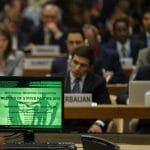Synthetic biology: Harbinger of an uncertain future?
By Malcolm Dando | August 16, 2010
It is hard to imagine that only three years ago, back in 2007, there was such a lack of awareness of dual-use and related biosecurity issues among practicing life scientists. Even the Biological and Toxin Weapons Convention (BTWC) was almost unknown. For me, this brand of unawareness was confirmed when, that year, Alexander Kelle attended “Synthethic Biology 3.0”, an international convention on synthetic biology that was held in Zurich, and interviewed some of the leaders in the field on dual-use and biosecurity issues. His conclusion?
“…only a small part of the interviewees, if any at all, were in a position to give an assessment of the various committees, reports, and recommendations addressed in the interview…”
Being a number cruncher by inclination, however, the clincher for me was that none of the 20 people interviewed had even heard of the report produced by the Lemon-Relman committee, the joint-committee of the U.S. Institute of Medicine and National Research Council. Their influential report, published in 2006, specifically made it very clear that concerns about the potential misuse of the modern life sciences went well beyond work on pathogens and toxins and certainly included the advances being made in synthetic biology. So it was indeed surprising that these leaders in the field had not even heard of the report.
It seems possible that some constructive development of the present annual meetings systems could be agreed upon at the next Review Conference in 2011; if so, maybe advances in science and technology could be one of the items given more frequent, perhaps annual, review by the States Parties.
Yet many would agree that the synthetic biology community, more so than any other community in the life sciences, has really made an effort to protect against the possible misuse of its benignly intended work. For example, Synthetic Genomic: Options for Governance was an illuminating study. It explained different points of intervention (gene firms, oligonucleotide manufacturers, DNA synthesizers, users, and organizations) and articulated various policy options that might be applied at each point (for example, education of the users about the risks and best practices in their university courses). After reading this study, it was clear to me that a serious effort was underway to develop ideas about effective means of protecting this science and technology from hostile misuse.
Development of policy ideas has continued apace in Europe and in the United States. In 2009, Kelle suggested what he called a “5P-governance matrix” in which possible intervention points (principle investigator, project, premise, provider, and purchaser) may have different potential biosecurity measures applied, and he has suggested how these ideas might be taken forward. Within weeks after scientists had created a “self-replicating cell that contained an entirely synthetic genome” in May of this year, President Barack Obama asked the U.S. Presidential Commission for the Study of Bioethical Issues to study the “implications of this technology” and to provide recommendations within six months as to what the federal government might do “to maximize benefits and minimize risks associated with this technology.”
Meanwhile there has been considerable activity in the industry itself, and in the U.S. government, both trying to hammer out an effective operational system to screen orders for DNA sequences and to minimize the possibility of misuse. After 9/11 U.S. firms began to use computer programs to compare the sequences ordered against a database of DNA sequences of viruses and bacteria that could be of concern. If an order appeared to closely match a sequence that could be used for hostile purposes, a company expert then investigated the security risk before the order was accepted. In 2006 a number of U.S. DNA synthesis firms that were applying such systems attempted to harmonize them within the International Consortium for Polynucleotide Synthesis. By 2007 five German firms had formed a different voluntary group with similar objectives, the International Association for Synthetic Biology. Then in 2009 an international meeting between European and U.S. experts led to a draft “Code of Conduct for Best Practices in Gene Synthesis.” All seemed to be going in the right direction.
However, a split in the industry appeared when two of the leading firms — DNA2.0 in the U.S. and Geneart in Germany — proposed to minimize the second phase of security screening, i.e. using a human expert, and to rely almost entirely on the first phase of screening, i.e. using only computers. Because a mainly computerized system would not require the time consuming and expensive work of an expert, it could be implemented quickly and cheaply. However, removing the detailed human expert examination obviously increases the possibility that dangerous orders could get through the screening, as the computer screening process is only as good as the databases it calls upon. Debates and divisions continue within the industry as to the best approach.
The U.S. National Science Advisory Board for Biosecurity (NSABB) also became involved in this issue, and in 2006 recommended that legally binding regulations should be developed for the synthetic biology industry. However, consideration within the U.S. government led instead to the proposal that a set of voluntary guidelines should be developed and then tested for some years. Last year the government issued its draft Screening Framework Guidance for Synthetic Double-Stranded DNA Providers. Unfortunately, the government’s proposal is weaker than those proposed by the industry groups because it involves using a more limited database of sequences in order to carry out the screening; consequently, dangerous orders could more easily get through the screening. It does seem therefore that an opportunity to rely on stronger measures developed by private industry could be undermined.
But all may not be lost, as this global industry may be subject to strong commercial pressures that could force it to comply with stronger voluntary guidelines. For example, powerful, important customers might not purchase from a firm that cannot demonstrate that it follows the industry’s best practices. It is also conceivable that the ongoing discussions in the U.S. will lead to a compromise on a set of stronger guidelines. We can all hope that events unfold in such a constructive way, and it is important that they do. Unfortunately, that will not solve the fundamental problem: By the time guidelines are agreed and implemented, the goalposts will have moved. Advances in science and technology will in the not-too-distant future deliver widely available bench-top synthesizers quite capable of producing what the industry now does. These developments will necessarily give rise to new biosecurity concerns. Clearly then we need a comprehensive system that will involve a continuous and coordinated international method more capable of getting to grips with the implications of the rapid advances in the life sciences than is now available.
Currently, a regular review of relevant science and technology developments at the Biological and Toxin Weapons Convention Review Conferences, which take place every five years, is the main mechanism available to governments. At the Fifth Review Conference in 2001-2, however, the UK government suggested that there was a need to alter this system because of the rate of change in science and technology. As the UK noted:
“…Given the accelerating pace in science and technology, the UK wonders whether it is prudent to maintain a five year gap between such assessments under the BTWC. The UK suggests that the upcoming Review Conference consider establishing a mechanism for States Parties to work together on a more frequent basis to conduct scientific and technical reviews and to consider any implications at the necessary level of expertise.”
It is unfortunate, but hardly surprising, that this suggestion did not get far in the deeply divided Fifth Review Conference.
Yet is worth noting that the UK put forward the same proposal in the most recent Review Conference in 2006 pointing out, in part, that “[T]he implications of new and rapidly emerging technologies such as synthetic biology…are difficult as yet to predict, but these are clearly areas with vast potential for both beneficial and detrimental applications.” Again there was no discernable movement to take up this suggestion in 2006. It seems possible that some constructive development of the present annual meetings systems could be agreed upon at the next Review Conference in 2011; if so, maybe advances in science and technology could be one of the items given more frequent, perhaps annual, review by the States Parties.
If some such comprehensive international mechanism of consideration of the implications of the advances in science and technology cannot soon be found, it seems to me that the probable failure to effectively regulate synthetic biology — because we will end up dealing with yesterday’s problem — will indeed be a harbinger of a very uncertain future in regard to the governance of other areas of the life sciences.
Together, we make the world safer.
The Bulletin elevates expert voices above the noise. But as an independent nonprofit organization, our operations depend on the support of readers like you. Help us continue to deliver quality journalism that holds leaders accountable. Your support of our work at any level is important. In return, we promise our coverage will be understandable, influential, vigilant, solution-oriented, and fair-minded. Together we can make a difference.
Topics: Biosecurity, Columnists















